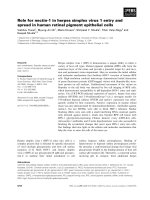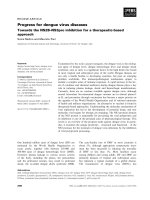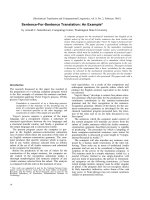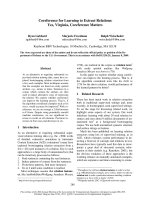Báo cáo khoa học: " Surfactant for acute respiratory failure in children: where should it fit in our treatment algorithm" doc
Bạn đang xem bản rút gọn của tài liệu. Xem và tải ngay bản đầy đủ của tài liệu tại đây (32.92 KB, 2 trang )
Page 1 of 2
(page number not for citation purposes)
Available online />Abstract
In a recent meta-analysis, surfactant administration in paediatric
acute respiratory failure was associated with improved oxygena-
tion, reduced mortality, increased ventilator-free days and reduced
duration of ventilation. Surfactant is expensive, however, and its
use involves installation of large volumes into the lungs, resulting in
transient hypoxia and hypotension in some patients. Many
questions also remain unanswered, such the as optimum dosage
and the timing of administration of surfactant. The merits of
surfactant administration should therefore still be decided on an
individual case-by-case basis.
Duffett and colleagues performed a meta-analysis of the six
published randomised trials of surfactant therapy in intubated
and ventilated children with acute respiratory failure [1]. In all
six trials, involving a total of 314 patients, surfactant
administration was associated with beneficial effects,
including improved oxygenation, reduced mortality, increased
ventilator-free days and reduced duration of ventilation.
The meta-analysis provides strong evidence for the use of
surfactant in acute respiratory failure in children, but where
should it fit in our treatment algorithm?
Optimising the ventilation settings remains the important initial
step in management of acute respiratory failure in children
requiring intubation. Ensuring that an appropriate tidal volume
(6 ml/kg) is used is important to avoid exacerbating the lung
injury with excessive tidal volumes [2]. In addition, an
appropriate positive end-expiratory pressure, a longer
inspiratory time, permissive hypercapnia and accepting lower
oxygen saturations (85–94%) should be attempted.
If the above therapies do not work, we are then faced with a
number of options, including surfactant, high-frequency
oscillatory ventilation, steroids, and inhaled nitric oxide. But in
what order should we use these options?
Using evidence-based medicine, the evidence is strongest for
the use of surfactant. Next favoured would be steroids, which
have been shown to improve oxygenation, to shorten the
duration of mechanical ventilation and to reduce the
multiorgan failure score in two randomised trials in adults
[3,4]; this therapy would then be followed by high-frequency
oscillatory ventilation, which reduced the oxygen requirement
in survivors in the one published randomised trial in children
[5]. Inhaled nitric oxide would rank last in this list as, although
it improved oxygenation in the first 24 hours, its use has not
been associated with any significant change in any other
outcome marker [6].
The use of surfactant in paediatric patients, especially larger
children, however, is expensive and requires instillation of large
volumes of surfactant into the lungs. With the current financial
restraints facing most intensive care units, the more frequent
use of surfactant would have large financial implications. Each
8 ml vial of Survanta (Abbott Laboratories, Maidenhead, Berks,
UK) used in our institution costs £300, thus the administration
of a single dose in a larger patient could cost thousands of
pounds. Similarly, the use of inhaled nitric oxide is expensive,
with 3 days of treatment costing £3,000. From the financial
point of view, therefore, high-frequency oscillatory ventilation
and steroids would rank more favourably.
What about the risks of each of the treatments? High-
frequency oscillatory ventilation and inhaled nitric oxide use
have not been associated with any significant increase in the
rates of adverse events [5,6]. Surfactant use was also not
associated with any serious adverse events; however,
transient hypotension and transient hypoxia did occur in some
patients [1]. Methylprednisolone use was associated with a
significant increase in 60-day and 180-day mortality when
patients were enrolled at least 14 days after the onset of the
acute respiratory failure. Methylprednisolone was also
associated with a higher rate of neuromuscular weakness [4].
Commentary
Surfactant for acute respiratory failure in children: where should
it fit in our treatment algorithm?
Margrid Schindler
Paediatric Intensive Care Unit, Bristol Royal Hospital for Children, Upper Maudlin Street, Bristol BS2 8BJ, UK
Corresponding author: Margrid Schindler,
Published: 19 July 2007 Critical Care 2007, 11:148 (doi:10.1186/cc5951)
This article is online at />© 2007 BioMed Central Ltd
See related research by Duffett et al., />Page 2 of 2
(page number not for citation purposes)
Critical Care Vol 11 No 4 Schindler
The ranking of these treatments is therefore difficult and
depends on which aspect is examined.
The next question is whether some patient groups respond
more favourably to one treatment or another. Three of the
randomised trials reported in this meta-analysis only involved
infants with viral bronchiolitis, who responded well to
surfactant [1]. Only three of the trials involved older children
with acute lung injury from a variety of causes. All of the trials
except that of Tibby and colleagues excluded patients with
chronic lung disease [7]. Only one trial enrolled patients with
cardiac disease or uncorrected congenital heart disease [8].
More studies are required in these patient groups.
Another issue is the optimum dosage and the timing of
surfactant treatment. Surfactant was used within the first
24–48 hours of intubation in three trials [7,9,10], and within
the first 5 days in another [8]. The timing of surfactant use
was not stated in the remaining two trials [11]. Patients with
milder degrees of hypoxia (oxygenation index 5–7) were
enrolled in three of the studies [7,9,10]. Moller and
colleagues also observed a better response if the PaO
2
/FiO
2
ratio was greater than 65 [8], again suggesting a better
response if surfactant is used early in less hypoxic patients.
Four of the six trials used 100 mg/kg phospholipids [7-10].
The remaining two trials performed by the same author used
50 mg/kg phospholipids in infants with viral bronchiolitis [11].
Further trials are required to determine whether smaller doses
of surfactant are effective in nonbronchiolitis patients.
Despite the apparently good evidence for the benefit of
surfactant in paediatric patients with hypoxic respiratory
failure, therefore, many questions remain unanswered – such
as the optimum timing of administration, what dose to use
and which patient groups are most suitable. We still need to
weigh up the pros and cons of using surfactant in each
individual patient to decide whether the surfactant benefits
outweigh the financial implications and risks in that particular
patient.
Competing interests
The author declares that they have no competing interests.
References
1. Duffett M, Choong K, Ng V, Randolph A, Cook DJ: Surfactant
therapy for acute respiratory failure in children: a systematic
review and meta-analysis. Crit Care 2007, 11:R66.
2. ARDS Network: Ventilation with lower tidal volumes as com-
pared with traditional tidal volumes for acute lung injury and
the acute respiratory distress syndrome. N Engl J Med 2000,
342:1301-1308.
3. Meduri GU, Golden E, Freire AX, Taylor E, Zaman M, Carson SJ,
Gibson M, Umberger R: Methylprednisolone infusion in early
severe ARDS: results of a randomized controlled trial. Chest
2007, 131:954-963.
4. Steinberg KP, Hudson LD, Goodman RB, Hough CL, Lanken PN,
Hyzy R, Thompson BT, Ancukiewicz M: Efficacy and safety of
corticosteroids for persistent acute respiratory distress syn-
drome. N Engl J Med 2006, 354:1671-1684.
5. Arnold JH Hanson JH, Toro-Figuero LO, Gutierrez J, Berens RJ,
Anglin DL: Prospective, randomised comparison of high-fre-
quency oscillatory ventilation and conventional mechanical
ventilation in pediatric respiratory failure. Crit Care Med 1994,
22:1530-1539.
6. Adhikari NK, Burns KE, Friedrich JO, Granton JT, Cook DJ, Meade
MO: Effect of nitric oxide on oxygenation and mortality in
acute lung injury: systematic review and meta-analysis. Br
Med J 2007, 334:779-782.
7. Tibby SM, Hatherill M, Wright SM, Wilson P, Postle AD, Murdoch
IA: Exogenous surfactant supplementation in infants with res-
piratory syncytial virus bronchiolitis. Am J Respir Crit Care
Med 2000, 162:1251-1256.
8. Moller JC, Schaible T, Roll C, Schiffmann JH, Bindl L, Schrod L,
Reiss I, Kohl M, Demirakca S, Hentschel R, et al.: Treatment with
bovine surfanctant in severe acute respiratory distress syn-
drome in children: a randomized multicenter study. Intensive
Care Med 2003, 29:437-446.
9. Willson DF, Thomas NJ, Markovitz BP, Bauman LA, DiCarlo JV,
Pon S, Jacobs BR, Jefferson LS, Conaway MR, Egan EA: Effect
of exogenous surfactant (calfactant) in pediatric acute lung
injury: a randomized controlled trial. J Am Med Assoc 2005,
293:470-476.
10. Willson DF, Jin Hua J, Bauman LA, Zaritsky A, Craft H, Dockery K,
Conrad D, Dalton H: Calf’s lung surfactant extract in acute
hypoxemic respiratory failure in children. Crit Care Med 1996,
24:1316-1322.
11. Luchetti M, Ferrero F, Gallini C, Natale A, Pigna A, Tortorolo L,
Marraro G: Multicenter, randomised, controlled study of
porcine surfactant in severe respiratory syncytial virus-
induced respiratory failure. Pediatr Crit Care Med 2002, 3:
261–268.









